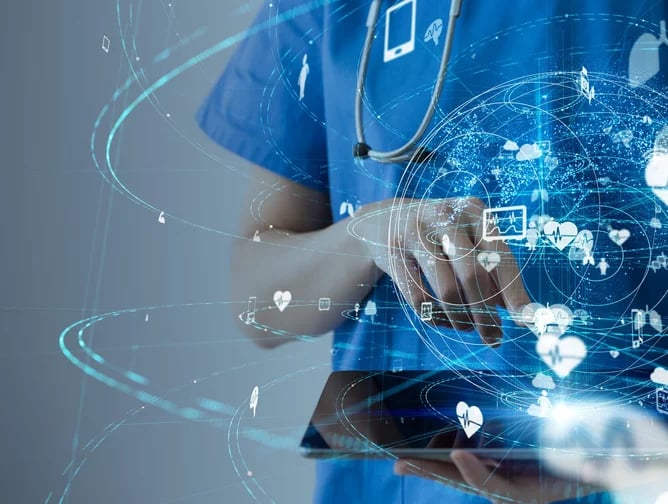As originally posted by Helen Sydney Adams in Healthcare

Hatem Zeine, Founder, President and CTO at Ossia, explains how wireless power technology can help hospitals and assist healthcare professionals.
Hi Hatem! Please introduce yourself and your role.
“I am Hatem Zeine, Founder, President and CTO at Ossia. I ensure that Ossia’s Cota wireless power technology reaches all its potential in servicing the future of IoT.”
Tell us about your education and career path.
“As a young child, I was always interested in how the world works. I had a strong curiosity around electronics and how machinery and devices work. With several years of experience in computer design and programming, I earned my bachelor’s degree in Physics from the University of Manchester in the UK. This education later became the foundation for my invention of wireless power that works just like Wi-Fi. The technology I’ve developed is called Ossia’s Cota Real Wireless Power.
“Previously, I founded Zeine Technological Applications then later was the Principal Test Architect at Microsoft for seven years.”
What led you to this industry?
“I believe that technological advancement is not moving fast enough and after the theoretical invention of this practical wireless power, it was apparent that this is a much-needed technology to enable the implementation and advancement of what we call today as IoT devices, helping in the deployment of more and new devices that will serve to improve our health, productivity, safety, security, education and entertainment.
“At that point, I felt there was no choice but to get into this industry.”
What is Ossia?
“Ossia is a technology development company, bringing to the world the game changing Cota technology that can power and charge devices from a distance, sort of the Wi-Fi for power. Headquartered in Redmond, WA, Ossia’s Cota technology redefines wireless power by safely delivering targeted energy to devices at a distance. Ossia’s patented RF smart antenna technology automatically keeps multiple devices charged without any user intervention, enabling an efficient and truly wire-free, powered-up world that is always on and always connected.”
Tell us about wireless power technology and how it can help hospitals?
“Modern hospitals are a marvel of technology; from the building itself and its HVAC, air quality and hygiene, to the patient care and monitoring systems, to the staff management. Patient monitoring and management is the most critical components, utilising many diverse devices to get the patients back to health.
“Healthcare professionals rely on many types of data gathering to monitor a patient’s health and vital signs. These systems are often power limited (limiting the functionality and lifespan of the devices), requiring the patient to be connected by wires and stationery in a hospital setting or at home with a battery-dependent device. Wireless power can overcome this healthcare challenge. When a monitoring device must constantly communicate their status not only to tell the healthcare staff that the patient is well, but also to tell them that the device is working fine. Wireless power means two things: The devices we have now can run forever without running out of power, but also the ability to increase the number and types of devices to increase the number of vital signs that can be monitored, without incumbering the healthcare staff with more devices to worry about.
“Wireless power can also assist with scalable medical deployment. The pandemic has shown us how our medical system is struggling to scale up in times of need due to equipment availability and sterilised devices. Part of this shortage of equipment stems from historical deployment. These devices rely on wiring, which is infrastructure and hard to scale when needed, or batteries, which are easy to scale but hard to maintain and keep sterile. By providing continuous power to devices in the hospital with real wireless power, we can now be free to add more devices without worrying about wires or changing batteries.”
What has been Ossia's greatest challenge?
“Ossia’s greatest challenge has been showcasing, and sometimes convincing, people that the future they imagine in 50+ years in the wireless power industry is here now, inherently safe and sustainable for our environment. We have received several FCC approvals of our Cota technology for use in over 60 countries including the United States and throughout the EU and the UK.
“We have also worked with Sustainalytics, a highly respected, independent research firm, to evaluate the impact on the environment with wireless power in the next five to ten years. The key takeaway is that batteries and wires are limiting IoT growth and do not support organisations’ sustainable development goals. Wireless power enables products to be developed lighter in weight and with a longer expected lifespan, ultimately reducing waste. The technology has the ability to dramatically impact our society, environment and economy in the next decade by avoiding up to 83,000 kilotons of waste, eliminating up to 476,000 standard containers of battery waste and saving up to 1.87B litres of water in its early deployment years.”
During your time here, what has been your biggest lesson?
“No matter how great the technology is, at the end of the day, it is the team that makes everything happen. Building a strong team from the get-go can have the most profound impact on the company’s short-term and long-term future.”
What do the next 12 months hold for you and Ossia?
“The next 12 months are going to be the most important for the company. With the Cota technology getting into people’s homes, offices and enterprises, we have our work cut out for us. I am very confident about our fantastic Ossia team to deliver on the promise of this game-changing technology.
“In 24 months, we will start saying “How did we live before we had this technology”. For some use cases, there is no other way for them to exist without wireless power.”
